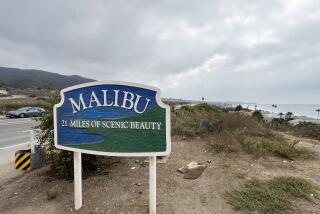Cracks Radiating From Ridgecrest Quakes Discovered : SCIENCE FILE / An exploration of issues and trends affecting science, medicine and the environment
CHINA LAKE, Calif. — Highly visible cracks, widening with each sizable aftershock, have been discovered about three miles both southeast and northwest of the epicenters of the recent magnitude 5.8 and 5.4 earthquakes north of Ridgecrest.
The cracking is not a full surface rupture, but reflects a radiation of seismic energy and strain outward from the ends of the fault strands, said Frank Monastero, a geophysicist at the China Lake Naval Air Weapons Station, where the quakes were centered.
From the location of the cracks, Monastero has concluded that it is likely that all of the quakes since the present sequence began Aug. 17 are within the same six- to seven-mile fault zone, along a steep plane dipping to the southwest. This suggests, he said, that a larger earthquake is unlikely in the near future, since no longer faults are involved.
Monastero, head of the geothermal program at the sprawling desert base, made the discoveries and mapped the cracks with other base personnel by using ground reconnaissance and a helicopter.
Monastero pointed out one series of cracks, 3 to 3 1/2 miles northwest of the epicenter of the 5.4 earthquake on Aug. 17, to a visitor last week. The cracks generally are along the base of an old quake scarp, where a single major earthquake or a series of quakes over a long time has raised the land a few feet above the surface along a northwest-southeast line.
Those cracks are about 70 feet in length and have expanded with aftershocks, but they are so narrow that they probably will soon be covered over by windblown dust and soil.
The other cracks--a little more than 111 feet long and in some cases nearly two inches across and more than six inches deep--were discovered after the 5.8 quake of Sept. 20 and are 2 1/2 to 3 miles southeast of the epicenter of that quake, which was a little more than a mile southeast of the Aug. 17 temblor. Those cracks are along both sides of a wide depression dug by the Navy in connection with weapons tests at the base.
“It’s clear that not only the 5.8 and 5.4 quakes enhanced the cracking, but also the 4.9 aftershock we had on Sept. 24,” Monastero said.
The cracking near Ridgecrest is akin to the surface deformation found in several locations north of the Northridge earthquake epicenter last year.
Caltech and the U.S. Geological Survey have sent more seismographic instruments to the area in Kern County, about 100 miles north of Los Angeles, to keep precise track of the seismicity in a region that has had more than 3,000 shocks in the last six weeks, most of them too small to be felt. Aftershocks continued this week.
A rupture is a much more dramatic feature than a deformation. In the 1992 Landers earthquake, the primary rupture was a tear through the earth 47 miles long, marked by ground displacements that occasionally reached more than 20 feet.
Monastero said all of the recent seismic activity appears to have taken place along an unnamed fault zone that intersects the north-south Airport Lake Fault near a line of hills south of the Coso volcanic field.
He said the geothermal record on the base would indicate that there is little or no chance of a volcanic component to the recent quakes.
Other series of quakes occurred nearby in 1981-82 and after the major Landers earthquake in 1992. Altogether, there have been more than 10,000 seismic events in the area since 1980.
More to Read
Sign up for Essential California
The most important California stories and recommendations in your inbox every morning.
You may occasionally receive promotional content from the Los Angeles Times.










